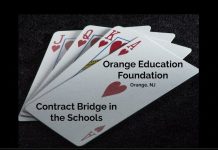Alvin P. Bluthman response Gjivo Tikvica asked for an explanation of Exclusion KeyCard Blackwood. I’ll try to provide an explanation of the concept, using a common example. Remember that many different variations are played, and that each variation will give different meanings to different bids. Therefore, others may use these concepts in quite different bidding sequences, and may (for example) use different step responses in identifying keycards. EKCB is a combination of two different types of Blackwood devices. In Exclusion Blackwood, the ace-asker announces a side-suit in which he is void; his partner does not count the ace of that suit, because it duplicates the void. In Key-Card Blackwood (what was once called Roman Key-Card Blackwood is commonly used today), the king of the trump suit is counted as if it were a fifth ace; together, these five “aces” are referred to as key-cards. Asking and responding structures differ, but here is the most common: 4NT asks for key-cards first step (5
Dave Slayton Response To add to the good response from APBluthman: You may also have other conventions in place where one partner or the other has shown shortness in some suit, and then one guy wants to ask for keycards. If the shortness has been clearly identified as a VOID (if it cannot be a singleton), then if the guy with the void asks for keycards after that, his partner is instructed to ignore the ace of that suit in counting up his keycards to determine his response. Lacking the ability to do this leaves the guy with the void in the dark about what to do if at least one keycard is missing. Is the “missing” keycard in the void suit? If so, you may be able to play in a grand slam. If not, 6 may be the limit. Lacking exclusion, he has no way of knowing which is the case. The guy with the void needs to know only about aces in the suits where the void ISN’T. If the known shortness is ambiguous (could be stiff or void), I and my partners play that if the very next bid by the guy showing the shortness is blackwood, then the keycard ask is considered to exclude the suit where the shortness was shown. So, if the guy showing shortness really has a stiff, he has to find a cuebid or other bid to make before asking for keycards (or let his partner ask) to avoid excluding the short suit from consideration.
Curtis Cheek Response This is indeed the version most commonly played, but seriously flawed. The 0/3 and 1/4 ambiguities which rarely cause a problem after 4NT (or other RKC substitutes) can lead to serious problems over Exclusion. Much better is to play old fashioned responses: 0/4, 1, 2, 3. Cheapest non-trump can be used for Q ask, and 2nd cheapest for K ask. This flaw was revealed in a match I played last year in which my partner passed what I thought was clearly Exclusion: 1
Barry Rigal Response Hi there Curtis Interesting point; would not the RKC bidder normally be able to make the temporising sign-off –unless the response was in the trump suit? –thus minimising the 0/3 ambiguity? bid 5




























